Hi, everyone! I’m Michael Zhang, a seasoned Chinese travel expert with a wealth of international travel experience. Over the years, I’ve been captivated by exploring the rich history, vibrant cultures, and stunning natural landscapes of destinations around the world. I’m passionate about sharing in-depth insights and stories from my travels. Today, let me take you on a journey to discover Mount Tai, the most revered of China’s Five Great Mountains. Together, we’ll explore its historical significance, cultural richness, and practical travel tips to make your trip unforgettable.
Introduction to Mount Tai
Mount Tai, also known as Dai Mountain, Dai Zong, and Tai Yue, is one of China’s Five Great Mountains. Often referred to as the “First of the Five Great Mountains,” “The Most Revered Mountain under Heaven,” and “China’s Olympus,” it is a UNESCO World Heritage Site and a top-rated 5A tourist attraction in China.
Covering an area of 25,000 hectares, the mountain’s highest peak, Jade Emperor Peak, reaches an altitude of 1,545 meters. In 1987, Mount Tai became the first Chinese site to be inscribed as a UNESCO World Cultural and Natural Heritage. Later, in 2006, it was recognized as a Global Geopark for its unique geological significance.
- Address: Tai’an City, Shandong Province, China
- Opening Hours: Gate closures outside operating hours vary by entry point:
- Hongmen Gate: Hiking entrance, 5:00 AM–11:00 PM
- Tianwai Village Gate: Vehicle entrance, 6:00 AM–9:00 PM
- Peach Blossom Valley Gate: Vehicle entrance, 7:00 AM–4:00 PM
- East Royal Road Gate: Hiking entrance, 8:00 AM–4:00 PM
- Tianping Lake Visitor Center: Vehicle entrance, 8:00 AM–8:00 PM
- Recommended Duration: 1–2 days
- Best Seasons to Visit: Spring, summer, and autumn offer the most vibrant experiences, though Mount Tai is stunning year-round.
- Peak Elevation: 1,545 meters

Why You Should Visit Mount Tai
Rich Historical and Cultural Significance
Mount Tai has served as a sacred site for emperors to perform rituals honoring heaven and earth since ancient times. Starting with Qin Shi Huang, six emperors, including Emperor Wu of Han and Emperor Xuanzong of Tang, held grand ceremonies here. Even during later dynasties, emperors such as Kangxi and Qianlong of the Qing Dynasty paid homage to Mount Tai. Standing atop its peaks, you can almost feel the weight of China’s long and illustrious history.
Stunning Natural Scenery and Seasonal Beauty
Each season on Mount Tai reveals a unique charm. Spring brings lush greenery, summer radiates vitality, autumn showcases vibrant hues, and winter wraps the landscape in a silvery blanket. Moreover, its sunrises and sunsets are among the most breathtaking sights, drawing many visitors to hike overnight just to catch the magnificent dawn.
An Ideal Spot to Explore Traditional Chinese Culture
Beyond its natural beauty, Mount Tai is a treasure trove of cultural heritage. The mountain is home to numerous ancient buildings, inscriptions, and carvings that illustrate its historical depth. Landmarks such as the Jade Emperor Temple, Bixia Temple, and Dai Temple offer a glimpse into the architectural and spiritual traditions of the past. Recognized by UNESCO for its dual cultural and natural significance, Mount Tai embodies the harmonious philosophy of “unity between heaven and humanity.”
Things to do in Mount Tai
Main Attractions
Dai Temple
Dai Temple is the largest and best-preserved ancient architectural complex on Mount Tai, known as the spiritual center of Taoism. Throughout history, it served as the main site for emperors to conduct grand ceremonies honoring the gods of Mount Tai. The temple features magnificent structures such as the Tian Kuang Hall and the Han Cypress Courtyard, showcasing profound historical and artistic value. Visitors need to purchase a separate ticket for 20 RMB. Dai Temple is a cultural symbol of Mount Tai and an unmissable highlight for any traveler.
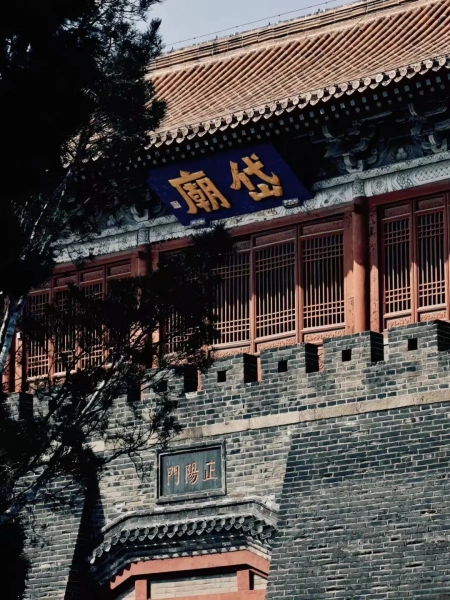
Eighteen Bends
The Eighteen Bends is the most iconic hiking route on Mount Tai, celebrated for its steep and challenging ascent. This section of the trail, stretching from the Middle Heaven Gate (Zhong Tian Men) to the South Heaven Gate (Nan Tian Men), zigzags sharply upward with over 1,600 stone steps. It is both a test of endurance and a rewarding experience, offering stunning views along the way. Considered the heart of the Mount Tai climbing experience, this route is a must for adventurous visitors.
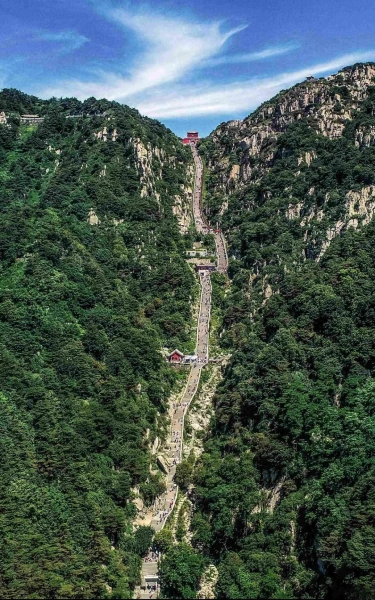
South Heaven Gate
Located at the end of the Eighteen Bends, the South Heaven Gate marks the pinnacle of Mount Tai’s winding trail. As the symbolic gateway to heaven, the structure boasts a grand and ancient architectural style. From this vantage point, visitors can take in breathtaking views of the mountain’s lower regions and gaze upon the majestic peaks above. This iconic site has become a popular stop for photography and reflection during the ascent.
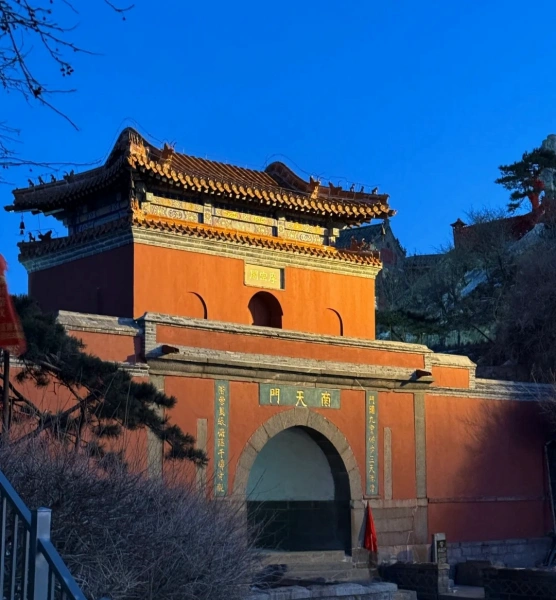
Jade Emperor Peak
Jade Emperor Peak is the highest point of Mount Tai, standing at an impressive 1,545 meters above sea level. It serves as the ultimate destination for climbers, offering panoramic views of the mountain. Here, you can witness spectacular sunrises, rolling seas of clouds, and vibrant sunsets. The peak is also home to the Jade Emperor Temple, rich in Taoist traditions. Standing on this peak embodies the spirit of “standing above all” and provides a moment of awe and inspiration.
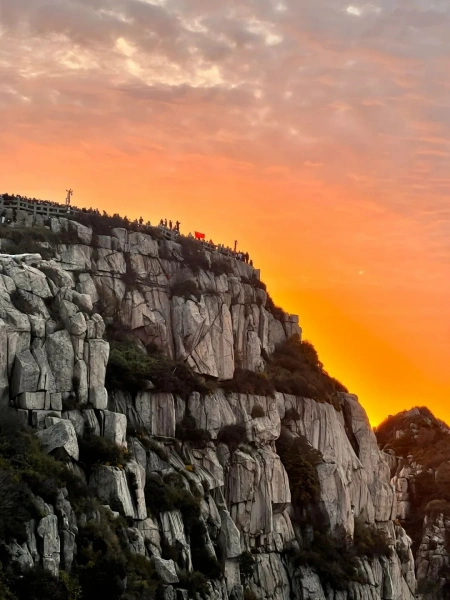
Inscription of “The Most Revered of the Five Great Mountains”
The inscription “The Most Revered of the Five Great Mountains” is one of the most famous stone carvings on Mount Tai, located halfway up the mountain. This powerful and elegant calligraphy symbolizes the mountain’s preeminent status among China’s Five Great Mountains. Featured on the 5 RMB banknote, the inscription has become a defining emblem of Mount Tai. Visitors often pause here to capture photos and appreciate the perfect blend of cultural heritage and natural beauty.
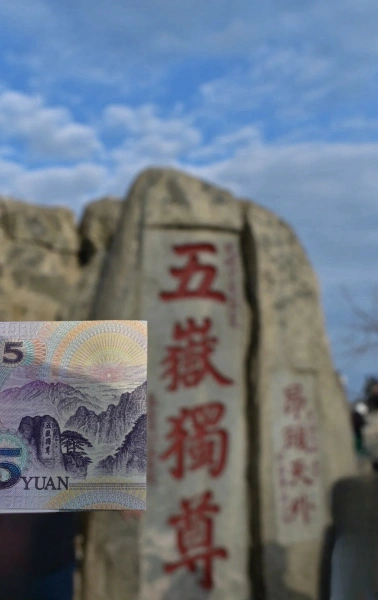
Mount Tai Ticket Guide
Mount Tai offers five types of tickets, depending on the route and entrance chosen. For first-time visitors, deciding which ticket to buy might feel overwhelming. Below are recommendations for ticket types and pricing to simplify your choice:
- Hongmen Gate Entrance: This is the classic hiking route to Mount Tai, popular among young and adventurous travelers.
- Tianwai Village Entrance: Ideal for those traveling with elderly family members or children, as this route includes vehicle access for a more relaxed journey.
Note: Tickets are entrance-specific. Once purchased, you must enter through the designated gate.
Ticket Prices
Hongmen Gate Entrance (Recommended)
- Includes: General admission to Mount Tai. Valid for three days from the first use with unlimited entries during this period.
- Adults: 115 RMB
- Children (6-17 years old): 57 RMB
- Free entry: Children under 6 years old or below 1.4 meters in height, and seniors over 60 years old.
- Opening Hours: 5:00 AM–11:00 PM
Tianwai Village Entrance (Recommended)
- Includes: General admission + shuttle bus from Tianwai Village to the Middle Heaven Gate.
- Adults: 150 RMB
- Children (6-17 years old): 92 RMB
- Seniors (60+ years old): 17 RMB
- Free entry: Children under 6 years old or below 1.4 meters in height.
- Opening Hours: 7:00 AM–9:00 PM
Peach Blossom Valley Entrance
- Includes: General admission + shuttle bus from Peach Blossom Valley to Peach Blossom Source.
- Adults: 150 RMB
- Children (6-17 years old): 92 RMB
- Seniors (60+ years old): 17 RMB
- Free entry: Children under 6 years old or below 1.4 meters in height.
- Opening Hours: 8:00 AM–4:00 PM
East Royal Road Entrance
- Includes: General admission. Valid for three days with unlimited entries.
- Adults: 115 RMB
- Children (6-17 years old): 57 RMB
- Free entry: Children under 6 years old or below 1.4 meters in height, and seniors over 60 years old.
- Opening Hours: 8:00 AM–4:00 PM
Tianping Lake to Middle Heaven Gate Entrance
- Includes: General admission + shuttle bus from Tianping Lake to the Middle Heaven Gate.
- Adults: 150 RMB
- Children (6-17 years old): 92 RMB
- Seniors (60+ years old): 17 RMB
- Free entry: Children under 6 years old or below 1.4 meters in height.
- Opening Hours: 8:00 AM–8:00 PM
Ticket Purchase Options
- Online: Official WeChat accounts or travel platforms.
- Offline: Tickets are available at visitor centers, but they are not recommended due to limited availability on busy days.
Recommended Mount Tai Hiking Routes
Route 1: Hongmen Hiking Route – The Classic Climbing Trail
- Route Overview: Dai Temple → Daizong Archway → Hongmen Palace → Wansian Tower → Doumu Palace → Jing Shi Yu → Hutian Pavilion → Hui Ma Ling → Middle Heaven Gate → Happy Valley → Yunbu Bridge → Wudafu Pine → Eighteen Bends → South Heaven Gate → Tianjie Street → Bixia Temple → Tang Mo Cliff → The Most Revered of the Five Great Mountains Inscription → Jade Emperor Peak → Gongbei Rock
- The Hongmen Hiking Route begins at Dai Temple (open from 8:00 AM to 6:00 PM, with the last entry at 5:30 PM) and is considered the essence of Mount Tai. Stretching 9.5 kilometers, this path features 7,863 stone steps and connects the most significant natural and cultural landmarks on the mountain. Known as the “Imperial Path,” it was the route emperors used for their sacred ceremonies. Along the way, you’ll encounter lush trees, steep cliffs, and a rich collection of historical relics, including eight ancient temples, over 200 steles, and 300 cliff carvings.
- Tips:
- This route is highly recommended for first-time visitors. Climbing Mount Tai without taking this path is considered incomplete.
- Hiking from Hongmen to the summit typically takes 4–6 hours. If starting from Dai Temple, add another 1–2 hours for exploration.
- The trail is physically demanding. If you feel fatigued, consider taking the cable car from Middle Heaven Gate to the summit.
Route 2: Tianwai Village Route – The Easiest Climbing Option
- Route Overview: Tianwai Village Visitor Center → Longtan Reservoir → Bailong Pool → Heilong Pool → Bamboo Forest Temple → Huangxihe Reservoir → Fanzi Cliff → Aolai Peak → Middle Heaven Gate → Cable Car → South Heaven Gate → Bixia Temple → Jade Emperor Peak
- The Tianwai Village Route (vehicle access available from 6:00 AM to 9:00 PM) starts at the Tianwai Village Plaza. This route is divided into two sections: the first is a 14.35-kilometer paved road from Tianwai Village to the Middle Heaven Gate, typically completed in 30 minutes by scenic shuttle buses. The second section, from Middle Heaven Gate to the summit, can be hiked (about 2 hours) or accessed via cable car (15 minutes).
- Tips:
- While convenient and less strenuous, this route skips many of the mountain’s iconic sights. To fully enjoy the scenery, consider walking from Middle Heaven Gate to the summit.
- This route is ideal for families with children or elderly members.
Route 3: Peach Blossom Valley Route – The Most Scenic and Romantic Trail
- Route Overview: Peach Blossom Valley Visitor Center → Angler’s Platform → Bifeng Temple → Colorful Stone Creek → Red-scaled Creek → Red Rain Canyon → Peach Blossom Source Cable Car
- The Peach Blossom Valley Route (vehicle access from 7:00 AM to 4:00 PM, hiking allowed from 8:00 AM to 4:00 PM) begins at the Peach Blossom Valley Visitor Center on the western side of Mount Tai. Due to its remote location, this route is popular among self-driving travelers.
- Tips:
- This route is less crowded, offering a serene hiking experience. If hiking, you can marvel at geological wonders like the 2.8-billion-year-old Colorful Stone Creek and the endemic Taishan Glider Fish.
- However, the cable car has a significant vertical drop, so it’s not recommended for visitors with a fear of heights or heart conditions.
Night Hiking Mount Tai
Route Overview: Hongmen Visitor Center → Ticket Gate → Middle Heaven Gate → Eighteen Bends → South Heaven Gate → Tianjie Street → Bixia Temple → Three Forks (1. Zhanlu Terrace 2. Sun-viewing Peak 3. Jade Emperor Peak)
- Best Sunrise Viewing Spots: Sun-viewing Peak and Jade Emperor Peak
- Night Hiking Tips:
- Prepare warm clothing: hand warmers, a thermos, hats, scarves, and insulated jackets are essential. Rental military coats are available at the summit for 50 RMB each.
- Safety gear: trekking poles (buy for 5 RMB per pair at the base), knee pads, gloves (for gripping the ropes on Eighteen Bends), and flashlights.
- Pack light: Bring only necessities like water and snacks. The trail is well-stocked with vendors selling water, sausages, tea, and more at reasonable prices (e.g., 10 RMB for 4 bottles of water or 10 RMB for 3 sausages).
- Start between 9:00 PM and 10:00 PM to maintain a steady pace and stay warm. Arriving at the summit around 5:00 AM allows you to rest briefly before witnessing the sunrise. Avoid arriving too early to prevent prolonged exposure to the cold.
Recommended Local Foods Near Mount Tai
After a rewarding climb, indulge in some of Tai’an’s local culinary delights. Here are a few favorites:
- Panda Chuanchuan Hotpot
- Location: Kunyuan Building, Yunzhao Street, Tai’an City
- Average Cost: 25 RMB per person
- Why It’s Special: This self-service hotpot lets you pick skewers (0.7 RMB each) and pay by weight. The broth is mildly spicy with a rich sesame flavor. Must-try: spiced potato skewers for a fragrant and satisfying snack.
- Guohua Suancai Soup House
- Location: No. 1-3, Quanfu Street, Tai’an City
- Average Cost: 10 RMB per person
- Why It’s Special: Known for unlimited main dishes like fried dough sticks and scallion pancakes for just 4 RMB per person. Their signature soup (4 RMB per bowl) combines barley, green onions, and ginger for a warming, satisfying meal.
- Favorite Spicy Chicken
- Location: No. 143 Caiyuan Street, Tai’an City
- Average Cost: 50 RMB per person
- Why It’s Special: The chicken is cooked with spicy green peppers for a mouth-tingling experience. The set meal includes sides like corn cakes, sticky rice, and tofu. Portions are generous, making it ideal for sharing.
Recommended Hotels Near Mount Tai
Visitors to Mount Tai can choose accommodations either on the mountain or at its base. Staying on the mountain is ideal for those who want to catch the sunrise, but the options are limited and typically more expensive.
Hotels on the Summit
- Shenqi Hotel
- Location: Near Jade Emperor Peak
- Price: 1400–1700 RMB per night
- Why Stay Here: The hotel staff will wake guests early for sunrise viewing and guide them to the best spots, just a 10-minute walk away. The hotel also offers hot showers for added comfort.
- Check Room Rates: View and Book
Hotels at the Base
- Swayter Movie Hotel (Daimiao Branch)
- Address: 214 Nanguan Street, Taishan District, Tai’an
- Price: 100 RMB per night
- Details: Conveniently located just an 8-minute drive from Tai’an Station.
- Check Room Rates: View and Book
- Yuecheng Lizhi Hotel
- Address: 4th Floor, Wanda Plaza, Taishan District, Tai’an
- Price: 200 RMB per night
- Details: Situated in the city center, this hotel is only 10 minutes by car from Tai’an Station, offering excellent transportation access and a comfortable stay at an affordable price.
- Check Room Rates: View and Book
- Ji Hotel (Tai’an Scenic Area Branch)
- Address: 256 Huanshan Road, Taishan District, Tai’an
- Price: 300 RMB per night
- Details: This chain hotel features mountain-view rooms and smart controls, located near Tianwai Village and Mount Tai Scenic Area.
- Check Room Rates: View and Book
Mount Tai Sunrise and Sunset Times
- Spring (March to May): Sunrise between 5:30 AM and 6:00 AM; sunset between 6:00 PM and 7:00 PM.
- Summer (June to August): Sunrise between 4:30 AM and 5:00 AM; sunset between 7:00 PM and 8:00 PM.
- Autumn (September to November): Sunrise between 6:00 AM and 6:30 AM; sunset between 6:00 PM and 7:00 PM.
- Winter (December to February): Sunrise after 7:00 AM; sunset between 4:30 PM and 5:30 PM.
Top Sunrise Viewing Spots: Jade Emperor Peak, Zhanlu Terrace, and Sun-viewing Peak.
How to Get to Mount Tai from Tai’an Station
By Bus
Several bus routes connect Tai’an Station to Mount Tai Scenic Area. For example, Bus No. 37 goes directly to Hongmen. The journey takes about 50 minutes and costs between 2 and 5 RMB.
By Taxi or Ride-Hailing
Taxis and ride-hailing services are the fastest way to get from Tai’an Station to Mount Tai Scenic Area. The trip takes around 40 minutes and typically costs 35 RMB.
How to Get to Mount Tai from Mount Tai Railway Station
By Bus
From Mount Tai Railway Station, you can take several bus routes to reach the scenic area. Bus No. 3 goes to Hongmen, and Bus No. 16 goes to Peach Blossom Peak. Buses run every 10–15 minutes, with a travel time of about 30 minutes. The fare is between 2 and 5 RMB.
By Taxi or Ride-Hailing
Taxis and ride-hailing services are convenient and quick, with a travel time of around 20 minutes and a fare of approximately 15 RMB.
How to Get to Mount Tai from Jinan Yaoqiang International Airport
By Airport Shuttle Bus
The airport shuttle bus is a budget-friendly option for getting to Mount Tai. Take the “Tai’an Line” bus to Dongdu Hotel in Tai’an, then transfer to Bus No. 2/K2 to reach Hongmen. The entire journey takes about 2 hours and costs between 60 and 80 RMB.
By Taxi or Ride-Hailing
Taxis and ride-hailing services are the fastest but most expensive option. The trip takes about 1.5 hours and costs between 300 and 400 RMB.
FAQ
Is Mount Tai Suitable for Strollers and Wheelchairs?
Some areas of Mount Tai, such as Dai Temple and the visitor centers at the base, are suitable for strollers and wheelchairs due to flat terrain and well-maintained facilities. However, steep paths like the Eighteen Bends are not accessible. For visitors with young children or limited mobility, the Tianwai Village route is recommended. This route includes vehicle access to Middle Heaven Gate, where a cable car can take you to the summit.
Where Can I Store My Luggage?
Small shops at the base of Mount Tai offer luggage storage services, typically charging 10 RMB per bag. This convenient service allows you to enjoy a hassle-free climb.

 English (US)
English (US)  English (Hong Kong)
English (Hong Kong)  English (Malaysia)
English (Malaysia)  English (Singapore)
English (Singapore)  繁體中文
繁體中文 
Comment (0)